Related Research Articles

The Scorpaeniformes are a diverse order of ray-finned fish, including the lionfishes and sculpins, but have also been called the Scleroparei. It is one of the five largest orders of bony fishes by number of species, with over 1,320.

The cabezon is a large species of sculpin native to the Pacific coast of North America. Although the genus name translates literally as "scorpion fish", true scorpionfish belong to the related family Scorpaenidae. The cabezon is the only known member of its genus.

Little velvetfishes or simply velvetfishes are a family, the Aploactinidae, of marine ray-finned fishes classified within the order Scorpaeniformes. They are small fish that have skin with a velvet texture. They live on the sea bottom close to the shore, at depths of up to 100 metres (330 ft). They are found in the Indo-Pacific region.

Scorpaenodes is a widespread genus of marine ray-finned fish belonging to the family Scorpaenidae, the scorpionfishes. The fishes in this genus are found to the Atlantic, Indian and Pacific Ocean.

Scorpaenopsis is a genus of marine ray-finned fish belonging to the family Scorpaenidae, the scorpionfishes. The fishes in this genus are found in the Indian and Pacific Ocean.

Rhinopias is a genus of marine ray-finned fish belonging to the family Scorpaenidae, the scorpionfishes. The species in this genus are found in the Indian and Pacific oceans.
Phenacoscorpius, the no-lined scorpionfishes, is a genus of marine ray-finned fish belonging to the family Scorpaenidae, the scorpionfishes. They are native to the western Atlantic, Pacific and Indian oceans.

Neomerinthe is a genus of marine ray-finned fish belonging to the family Scorpaenidae, the scorpionfishes. They are found in Atlantic, Indian and Pacific Ocean.

Rhinopias frondosa, the weedy scorpionfish or the weed fish, is a species of marine ray-finned fish belonging to the family Scorpaenidae, the scorpionfishes. This species is found in the Indo-West Pacific. It is a rare but highly desirable fish in the aquarium trade.

Rhinopias eschmeyeri or Eschmeyer's scorpionfish or mauritius scorpionfish, is a species of marine ray-finned fish belonging to the family Scorpaenidae, the scorpionfishes. This species is found in the Indo-West Pacific. It grows to an average size of 16.6 cm in length. It occasionally makes its way into the aquarium trade. Although some have raised questions as to whether R. eschmeyeri is a morphological variant of Rhinopias frondosa rather than a separate species, a 2006 study by Motomura and Johnson confirmed the species' existence and distinguished it from other members of the genus Rhinopias. It is sometimes confused with the leaf scorpionfish.
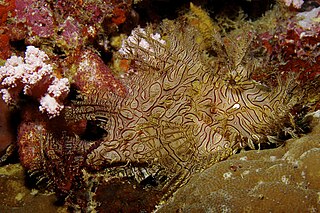
Rhinopias aphanes, the lacy scorpionfish, weedy scorpionfish or Merlet's scorpionfish, is a species of marine ray-finned fish belonging to the family Scorpaenidae, the scorpionfishes. This species is found in the Western Pacific. It occasionally makes its way into the aquarium trade.
Poss's scorpionfish is a species of venomous marine ray-finned fish belonging to the family Scorpaenidae, the scorpionfishes. It is found in the Indo-Pacific region. It occasionally makes its way into the aquarium trade.

Easchmeyer nexus is a species of marine ray-finned fish; it is the only species in the monotypic genus Eschmeyer and monogeneric family Eschmeyeridae. This fish is only known from the Pacific Ocean, near Fiji.
Rhinopias cea, or Cea's scorpionfish, is a species of marine ray-finned fish belonging to the family Scorpaenidae, the scorpionfishes. This species is only known from two sites in the southern Pacific Ocean.
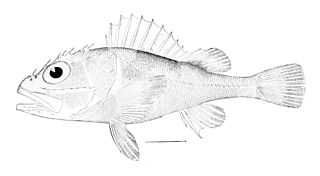
Trachyscorpia is a genus of marine ray-finned fish belonging to the subfamily Sebastinae, the rockfishes, part of the family Scorpaenidae. The species in this genus are found in the Atlantic, Indian and Pacific oceans.
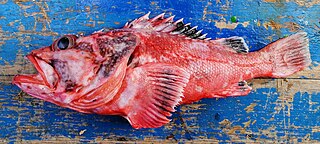
The spiny scorpionfish is a species of marine ray-finned fish belonging to the subfamily Sebastinae, the rockfishes, part of the family Scorpaenidae. It is found in the eastern Atlantic Ocean and the Mediterranean.
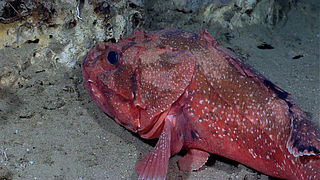
The Atlantic thornyhead is a species of marine ray-finned fish belonging to the subfamily Sebastinae, the rockfishes, part of the family Scorpaenidae. It is found in the western Atlantic Ocean and the Caribbean Sea.
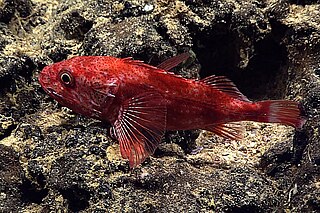
The channelled rockfish, commonly known as the deepwater scorpionfish, is a marine ray-finned fish belonging to the subfamily Setarchinae, which is a part of the family Scorpaenidae. This species is found in various tropical and subtropical oceans and has a wide distribution.

Scorpaeninae is a subfamily of ray-finned fish belonging to the family Scorpaenidae in the order Scorpaeniformes, it includes the scorpionfishes, the lionfishes and turkeyfishes. They bear venomous spines in the anal, dorsal and pelvic fins which can cause severe pain in envenomated humans. The subfamily is distributed in the tropical and temperate seas around the world.

The humpbacked scorpionfish is a species of venomous marine ray-finned fish belonging to the family Scorpaenidae, the scorpionfishes. This species is found in the western Indian Ocean.
References
- 1 2 "William Neil Eschmeyer". Gale Literature: Contemporary Authors . Gale. 24 October 2014. Gale H1000029758 . Retrieved 20 October 2024.
- 1 2 "Eschmeyer's Catalog of Fishes". California Academy of Sciences. 2 October 2024. Retrieved 20 October 2024.
- 1 2 "Ichthyology: Current Staff + Students". Florida Museum of Natural History. Retrieved 20 October 2024.
- ↑ Eschmeyer, William N.; Fricke, Ronald; Fong, Jon D.; Polack, Dennis A. (2010). "Marine fish diversity: history of knowledge and discovery (Pisces)". Zootaxa. 2525 (1): 19–50. doi:10.11646/zootaxa.2525.1.2.
- ↑ "William N. Eschmeyer". California Academy of Sciences. Retrieved 20 October 2024.
- ↑ Christopher Scharpf. "The ETYFish Project" . Retrieved 20 October 2024.
- ↑ Motomura, Hiroyuki; Kanehira, Naoko; Imamura, Hisashi (2012). "Redescription of a poorly known southeastern Pacific scorpionfish (Scorpaenidae), Phenacoscorpius eschmeyeri Parin and Mandrytsa". Species Diversity. 17 (2): 145–150. doi:10.12782/sd.17.2.145.
- Poss, S.G. & Eschmeyer, W.N. 1980. Xenaploactis, a new genus for Prosopodasys asperrimus Günther (Pisces: Aploactinidae), with descriptions of two new species. Proceedings of the California Academy of Sciences, (Series 4) 42(8), pages 287–293